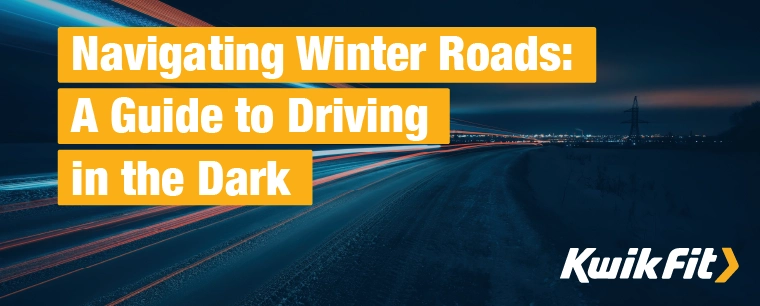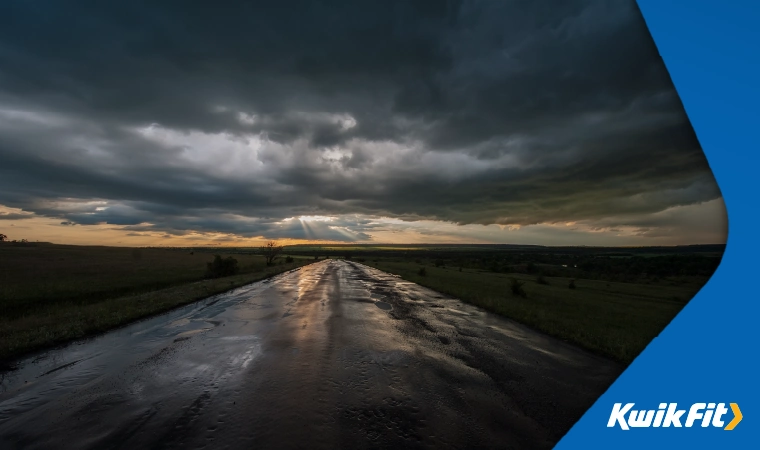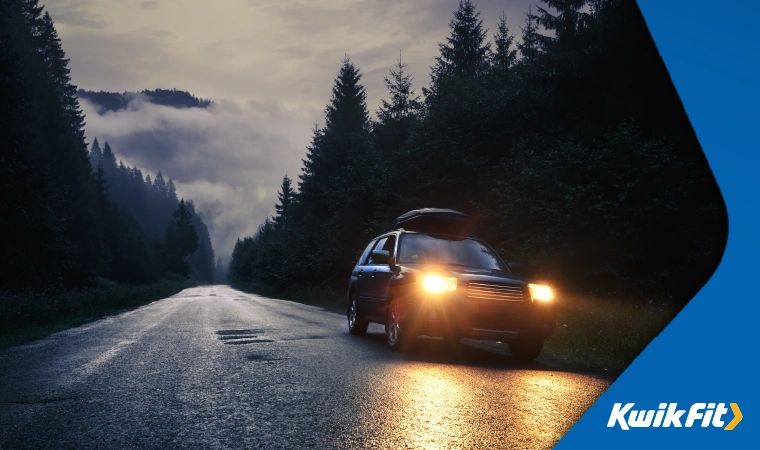Navigating Roads in Winter: A Guide to Driving in the Dark
Jack Dreyer | Friday 1st December 2023 4:00pm

Nobody likes driving in the dark, especially when itís cold and wet outside. That being said, driving in the winter months, when the weatherís poor and the roads are in darkness from late afternoon to early morning, can be a bit of a nightmare.
From slippy terrain to reduced visibility, navigating roads in winter isnít the simplest of tasks and can lead to a few scary moments behind the wheel.
On that note, according to recent research from Admiral, the 4th of December has been named the most dangerous day to drive, as they receive the most number of claims then. Similarly, 7 of the other top 10 most dangerous days were also on winter days in December.
As such, weíve produced a guide to driving in the dark during winter to help you and your passengers stay safe on the school run or when on your way to work.
The challenges of driving at night in winter
Unlike cruising down the motorway on a nice summerís day, navigating roads in the dark is a different story, especially in mid-winter. There are a whole host of new challenges that present themselves to drivers when the sun goes down on winter evenings ó from reduced visibility to dealing with the glare from other driversí headlights.
Letís take a look at some of these now.
Reduced visibility
To run the risk of stating the obvious, when you drive at night, you simply canít see as well as when you drive during daylight. A driverís field of vision is significantly reduced without the help of natural light, making it much harder for them to spot hazards.
Not only does this pose a greater threat to the safety of the driver and their passengers, but also to other road users and wildlife since things like bikes or pedestrians without reflective clothing and animals crossing the road are significantly harder to spot in the dark. All of these things elevate the risk of accidents happening.
Dealing with glare
In order to see better, vehicle headlights can be used ó either dipped, normal, or full beam. However, this presents its own set of unique challenges to road users.
Unfortunately, headlights from other vehicles can cause glare, especially if coupled with wet weather conditions. This can actually have an inverse effect, reflecting off of puddles and any surface water and making it very difficult to see.

Wet road surface
Lastly, water lying on the road surface is much more problematic at night than in the day. For one, it is much harder to spot puddles and standing water at night, increasing the risk of driving through it at speed and aquaplaning.
Secondly, as we mentioned above, in winter when the weather is generally wetter and darker, water standing on the road can cause glare and spray up and distract drivers, posing a whole set of problems.
In the long term, water on the roads can freeze and expand, causing potholes (over a course of months) which is, again, another hazard of winter driving, especially in the dark when they cannot be seen.
Winter dark driving tips
Now that weíre aware of the main challenges associated with dark, winter driving, letís explore how you can keep yourself and your passengers safe with the following tips.
Lights
Checks & maintenance
First and foremost, it is essential that you keep your lights in good working order to stand you in the best stead for safe night driving. These not only allow you to see the road, but signal other drivers to your presence in reduced visibility such as darkness or fog. The bullet points below outline a thorough list of things to consider when preparing your lights for driving in the dark:
- You should regularly give your headlights a thorough clean to reduce the build-up of any dirt or debris that may have accumulated there and be obscuring the strength of the beam. Additionally, if it is a particularly cold day, check that any ice or snow is not covering the lights too.
- Occasionally, the headlight cover on older vehicles can mist or get scratched, leaving a grey tinge to the clear plastic that can dampen the effectiveness of even the brightest bulbs. If you notice this has happened to your headlight covers, a bit of elbow grease should buff some life back into them in no time. In some instances, you can apply a protective coating or film to your headlight covers to ensure they are protected from salt on the roads or any other debris that may flick up while driving.
- Check the brightness of your headlight bulbs. If they are looking dim or yellowing, the chances are it is time to replace them soon. Replace any burnt-out bulbs with brighter, winter-specific alternatives. But, be careful not to go too bright or coloured, or you could risk violating the highway code.
- Ensure your bulbs light up for both high and low beams, as well as checking that your indicator and hazard lights work as these are essential in the dark. If you are caught driving with one headlight, you run the risk of landing yourself with a fine.
- Lastly, it may be the case that the angle of your headlights is not sitting quite right, preventing you from fully illuminating the part of the road in front of you. To remedy this, check the alignment of your headlights by turning them on in the dark and flicking between high and normal beams. If the angle isnít right, it may dazzle other drivers, so it is essential to sort this if you notice an issue.
Headlight best practice
Equally as important as making sure your headlights are in good working order is knowing how best to use them. Knowing when to switch to and from full beam to ensure you can see as much of the road as possible without dazzling other drivers is essential for driving (especially on roads with dips and hills) in the dark during winter. As a general rule of thumb, follow the bullet points below for best practice:
- If you are a new driver, or in a new car, make sure you know exactly how to turn your headlights on and switch between high and low beams.
- Remember when youíve got your headlights on full versus low beam. Hint: there will be a blue headlight icon showing on the dash when full beams are on.
- When dusk approaches, or during early mornings when it is dark, turn your dipped headlights on.
- Only use your full or main beams when it is safe to do so. This is when other road users are not near you (otherwise you run the risk of dazzling them).
- If you are using a full beam, reduce them back down to dipped beams as soon as another car comes into view.
- Try not to get fixated on the headlights of other users and get distracted. As best practice, if youíre beginning to feel blinded, keep your eyes on the white line to the left of you and slow down a little to stay straight on your side of the road.

Mirrors & blind spots
Keep your windows and mirrors clean when driving in the dark, especially at night when it is cold. Any debris or condensation on the windshield or mirrors has the potential to increase the glare caused by the beams of other vehicles.
During wet and icy weather in the winter, going slower and allowing for more time become even more important as stopping distances get much longer and driving becomes more dangerous.
Speeds
As another best practice, give yourself time. First, give yourself time to complete the journey youíre making ó and then some. Generally, journeys at night may take a little longer than in the day as other drivers are going slower and being cautious. So, reduce the likelihood of having to rush. Secondly, lower your speed to give yourself time to respond to any changes as they may unfold ahead of you. This is one of the most useful things you can do to reduce the risk of road accidents.
When it comes to blind spots, everything is much harder to see at night (as weíve established), so take extra care when checking your mirrors and blind spots before manoeuvring. Also, make sure your rearview mirror is positioned to its night setting to prevent the cars behind you from dazzling you.
Driving on unfamiliar roads?
Lastly, at night, even the most familiar roads can look completely different ó road signs can be obscured by fog or certain points of reference might not be visible at night time. So, make sure you use a satnav or are clear on the directions you need to take to get from A to B.
With sat navs, if possible, make sure the brightness of the screen auto adjusts to low lighting (or adjust it manually) so that it doesnít distract you from concentrating on the road.
Stay safe on winter nights
If you have to make a journey of an evening this winter, make sure you follow the steps above to keep you, your passengers, and fellow road users safe. If you have any questions about driving or your vehicle, get in touch with the friendly team at your local Kwik Fit, or, for the latest guidance, follow the Kwik Fit blog.
Any facts, figures and prices shown in our blog articles are correct at time of publication.
Featured Articles
Is it Illegal to Drive With One Headlight?
Saturday 19th July 2025
Wondering if itís illegal to drive with one headlight? Learn about the safety risks and penalties of illegal blown bulbs and why you should fix them promptly.
Air Con in EVs & Hybrids: Experts Answer Your Questions
Monday 30th June 2025
Does air con drain EV batteries? Can you use the air con while charging an electric car? Find out the answers to these questions & more from Kwik Fitís experts.
Why Is Your Car Making a Noise? Fixes & Tips
Friday 13th June 2025
When your car starts making unexpected noises, it can certainly be quite disconcerting; it may be nothing to worry about, but hereís what you need to know.









